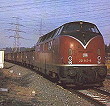|
Diesel-hydraulic locomotive introduction
The history of the Western Region diesel-hydraulic designs began in 1955 with the decision of the British Transport Commission (BTC) to update and improve the British railway system through the use of diesel traction as called for in the Modernisation Plan. At that time, just five diesel locomotives were in main-line operation and all were of the diesel-electric type of unit. Several locomotive manufacturers were encouraged to produce small groups of pilot scheme locomotives and after various trials, large scale construction of the better designs would follow.
The Western Region approached the BTC with regard to the employment of diesel-hydraulics as its new standard. The WR's arguments in favour of its use as against diesel-electric were due to the introduction of the V200 diesel-hydraulic locomotives for the German Federal Railways in 1953. These five locomotives of 2100 hp used a lightweight stressed-skin construction, reducing the overall weight to 80 tons compared with the new SR/Bullied diesel-electrics of 2000 hp and over 120 tons. In their eyes, this reduction in locomotive weight meant an increase in haulage weights by an extra coach or two. The Western Region also presumed that the lighter locomotive would be cheaper to build. Upon this, permission was given to order a small number of diesel-hydraulics as part of the pilot scheme.
The only problem remaining for the BTC was the question of who would build the locomotives. Importing complete locomotives from Germany would never be a politically correct solution, but it was found that the North British Locomotive Company of Glasgow had obtained a licence to produce the German Voith hydraulic transmission in 1951 and also a licence to manufacture MAN diesel engines in 1954, whereupon the BTC ordered two types of diesel-hydraulic locomotives with NBL. One design was for a Type 4 A1A-A1A locomotive with two engines producing a total of 2000 hp which became the D600 'Warship' series, whereas the other design was for a Type 2 B-B locomotive with a single engine producing 1000 hp. These locomotives were known as the D6300 'Baby Warship' class. Unfortunately, NBL did not have any experience in stressed-skin body construction and so in conjunction with the BTC, the design criteria was altered to utilise a chassis using ' I ' section beams and cross members which were riveted and welded together, as the BTC could see no reason to complicate the design using non-standard methods of construction. This increased the weight of the Type 4 to 117 tons (37 tons above that of the V200) and 68 tons in the smaller single engine Type 2. It is worth noting that the design of the Type 2 D6300 series was very similar to the NBL built D6100 series ( Class 21 ) diesel-electric  locomotives and the BTC saw this as an excellent opportunity to directly compare the two types of transmission as both designs used the same MAN engine. locomotives and the BTC saw this as an excellent opportunity to directly compare the two types of transmission as both designs used the same MAN engine.
When the Western Region were told of the locomotives on order through the BTC, they realised that all possible advantages that lightweight stressed-skin construction would have given, were completely wiped out by this alteration in the design. The WR then contacted the manufacturers of the V200, Krauss - Maffei, to enter discussions on the design of a British version. The dimensions of the V200 had to be scaled down considerably due to the British loading gauge, but within a short time, Swindon designers had drawn out a B-B design of 2200 hp and 80 tons using two Maybach engines, Mekydro hydraulic transmission and a lightweight stressed-skin body.
Again the Western Region approached the BTC, but this time to ask for backing for their own design of a Type 4 locomotive with construction at Swindon. This the Commission allowed, so therefore, the WR found itself with 14 pilot scheme locomotives on order : five D600 Warships and six D6300's, neither of which the WR really wanted, and three of the Swindon designed D800 Warships.
In the months that followed, pressure from outside circles meant that BTC's plan of small pilot scheme orders was practically scrapped in an attempt to accelerate the withdrawal of steam. Although the first of the Swindon D800 and NBL D6300 locomotives were not expected until mid to late 1958, in February 1957 the BTC ordered another 30 D800 series to be built at Swindon, and in November of that year, 52 D6300 locomotives were ordered from NBL. To add insult to injury, an additional order for 30 D800 locomotives was given to NBL in July 1958 when the first of the Swindon built locomotives were undergoing trials, whereas Swindon were asked to built just another 5. At the same time, the BTC ordered various types of diesel-electric locomotives from different manufacturers, so any hope of standardisation was abandoned. This
ultimately led to the downfall of the diesel-hydraulic locomotive in Britain.
|
 locomotives and the BTC saw this as an excellent opportunity to directly compare the two types of transmission as both designs used the same MAN engine.
locomotives and the BTC saw this as an excellent opportunity to directly compare the two types of transmission as both designs used the same MAN engine.